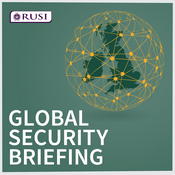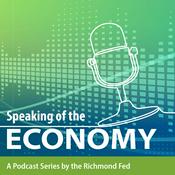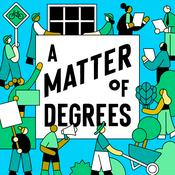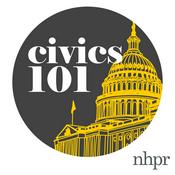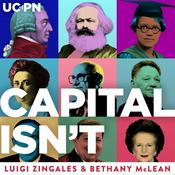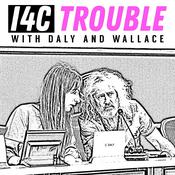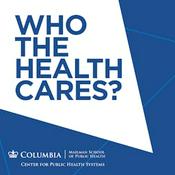232 episodes
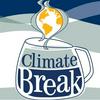
Rerun: AquaFreezing to Slow Arctic Ice Loss, with Simon Woods
23/12/2025 | 1 mins.
Real Ice, a UK based start-up, has been on the forefront of exploring the viability of this new technology. Aqua Freezing involves drilling holes through sea ice to pump out the sea water below and refreeze it on the surface. Once the water freezes, it thickens existing ice to the surface. Adding snow insulation in late winter is expected to help ice persist through summer melts, thereby reducing the risk of a "Blue Ocean Event." This solution targets climate change by maintaining Arctic ice cover, which can stabilize local ecosystems and moderate global climate impacts. If the project is successful, it is projected to postpone the loss of ice caps by approximately 17 years for each year this is completed. For every four feet of water pumped onto the surface, it is projected that the ice will cover around 3 feet. The Decline of Arctic Sea IceAs climate change heightens temperatures and alters climatic conditions, summer sea ice in the Arctic is melting rapidly. By the mid 2030s, it is predicted that a “Blue Ocean Event” (or BOE) will occur, meaning that the Arctic Ocean is expected to have less than one million square kilometers of sea ice. This equates to just 15% of the Arctic’s seasonal minimum ice cover of the late 1970s. As ice continues to melt, more of the ocean will be exposed to the sun's rays, thus absorbing more heat and accelerating warming. The Arctic has warmed four times faster than the rest of the world since 1979, largely due to this positive feedback loop known as Arctic amplification. Since the 1980s, the amount of Arctic sea ice has declined by approximately 13% each decade. As the BOE unfolds, it will trigger significant impacts, including droughts, heatwaves, accelerated thawing of terrestrial permafrost (releasing emissions in the process), and sea level rise. The Arctic plays a critical role in climate stabilization by acting as a large reflective surface, helping to cool the planet and maintain a stable global temperature. The BOE is thus a major climatic tipping point with catastrophic global consequences. A new methodology has been proposed to protect and restore Arctic sea ice known as Aqua Freezing. This approach uses renewable energy-powered pumps to distribute seawater on existing Arctic ice, allowing it to refreeze and thicken, helping to maintain climatic stability.The plan aims to target over 386,000 square miles of Arctic sea ice, an area larger than California. The process of refreezing already shows promise in field tests conducted over the past two years in Alaska and Canada. Proponents of refreezing Arctic sea ice believe that this technique would buy the region time while we make the necessary emissions cuts to curb the impacts of climate change. Refreezing ice would also preserve the albedo effect, which reflects sunlight back into space, preventing warming. Although AquaFreezing offers a potential solution to combat Arctic melting, scientists and policymakers doubt whether sea ice can be grown over a long enough period to make a true difference in the climate crisis. Further, the project is quite costly, equating to over 5 trillion dollars and demanding more steel than the US produces in a single year. The project would require 10 million pumps; however, this would only cover 10% of the Arctic Ocean’s roughly 4 million square mile size. To cover the entire area would require 100 million pumps and roughly 100 million tons of steel each year. The US currently produces around 80 to 90 million tons of steel a year, so covering just 10% of Arctic ice would require 13% of US steel production. The production required for the project could lead to immense environmental degradation and added emissions in the process. About Our GuestSimon Woods, co-founder and Executive Chairperson of Real Ice, is hopeful that this solution will buy the region time while we make the necessary emissions cuts to curb climate change. Real Ice believes this innovative solution can preserve sea ice and thus work to combat climate change. ResourcesArctic News, Blue Ocean EventCNN, A controversial plan to refreeze the Arctic is seeing promising results. But scientists warn of big risksRealIce, Introducing AquaFreezing: Encouraging the natural process of Arctic sea ice generation.Smithsonian Magazine, Arctic Could Be Sea Ice-Free in the Summer by the 2030sSustainability Times, Controversial Arctic Refreezing Plan Shows Promise, but Risks RemainWarp Notes, They are developing a technology to restore sea ice in the ArcticFurther ReadingYoutube, Scientists’ Crazy Plan To Refreeze The ArcticFor a transcript, please visit https://climatebreak.org/real-ice-with-simon-woods/.

Sequestering Carbon in Building Materials, with Dr. Sabbie Miller
16/12/2025 | 1 mins.
Introduction to the SolutionUC Davis researchers are examining a novel approach to combating climate change: turning our buildings into carbon sinks. The solution is based on incorporating biochar, a carbon-rich material obtained from plant material, into common construction materials like concrete, brick, and asphalt. By embedding carbon directly into long-lasting infrastructure, this approach reduces atmospheric CO₂ and also transforms one of the most carbon-intensive industries in the world into a tool for climate mitigation.Background: How Carbon Storage in Building Materials WorksBiochar is created through pyrolysis, a process involving heating organic material, such as crop residues or wood waste, in a low-oxygen environment. This process locks in carbon that plants absorb during photosynthesis and prevents it from being re-released into the atmosphere through decay or burning.The research team at UC Davis, headed by Professor Sabbie Miller and Dr. Elisabeth Van Roijen, proposes the use of biochar as a partial replacement for the materials in concrete and other construction compounds. Since more than 20 billion tons of concrete are produced every year by the construction sector, substituting 10% of that with biochar-based mixtures could store up to 1 gigaton of CO₂ annually, or the equivalent yearly emissions from Japan.Unlike temporary carbon storage methods, like soil burial, embedding biochar in durable infrastructure ensures long-term sequestration, potentially spanning decades or even centuries. It also leverages the global scale of construction as a medium for climate action.Advantages of This SolutionApart from net carbon emissions reduction, the introduction of biochar-enriched building materials has tangible engineering benefits. It has been found that the addition of biochar can enhance thermal insulation, fire resistance, and durability in some uses. The process also fits well within the circular economy principles because of the organic waste used and reduced need for virgin materials.Because construction is already a high-volume, resource-intensive industry, integrating biochar into existing supply chains could make climate-positive practices scalable and economically viable without requiring dramatic infrastructure overhauls. Equally important, this solution provides dual benefits: supporting both carbon sequestration and the development of sustainable materials.Drawbacks and CritiquesThe approach faces several scientific and logistical obstacles despite such a promising premise. Producing biochar requires energy in quite significant quantities, with sourcing biomass at large scales risking unforeseen ecological impacts such as nutrient depletion or habitat disruption. Some critics even ask whether its broad adoption might inadvertently encourage the removal of older buildings in favor of the construction of newer, carbon-storing ones, offsetting any climate gains.Another factor is the life cycle of the biochar-infused materials themselves. While they can store carbon for decades, it remains undetermined how these materials at the end of a building's life are to be managed to avoid re-release of CO₂. Future policy frameworks and recycling technologies will be required to address these challenges if there is to be long-term effectiveness.About the GuestDr. Sabbie Miller is an Associate Professor of Civil and Environmental Engineering at UC Davis. Her research focuses on sustainable infrastructure materials, life-cycle assessment, and reducing the environmental footprint of the construction industry.Further ReadingUC Davis News: Storing Carbon in Buildings Could Help Address Climate ChangeNature Geoscience: Carbon Sequestration Using BiocharScience Magazine: Building Materials as Carbon SinksScienceDirect: Alternative Sequestration Options in Construction MaterialsFor a transcript, please visit https://climatebreak.org/sequestering-carbon-in-building-materials-with-dr-sabbie-miller/

Rerun: Sustainable Wood from Mass Timber, with Dr. Paul Mayencourt
13/12/2025 | 1 mins.
How Sustainable Wood Helps Mitigate the Impact of Climate ChangeSustainable wood refers to the use of mass timber, which involves smaller pieces of wood that are dried and glued together in a perpendicular, crosswise pattern to form large slabs. This process can incorporate a closed-loop system that repurposes wood, promoting a circular practice that minimizes wood waste and reduces landfill usage, transportation needs, and carbon emissions. Additionally, the wood retains the carbon absorbed by trees during their growth, storing it in the floors and walls of buildings. As infrastructure demands increase, sustainable wood offers an environmentally friendly solution to meet these needs.Why the Construction Industry Needs Sustainable WoodSustainable wood, particularly through the use of mass timber, is gaining recognition as a critical climate solution in the construction industry. Traditional building materials like concrete and steel are carbon-intensive to produce, responsible for nearly 8% of global carbon emissions. In contrast, mass timber is derived from a renewable resource: trees. Through responsible forest management, trees can be harvested and replanted in a sustainable cycle, allowing forests to continue absorbing carbon dioxide. The wood used in mass timber stores this carbon long after the trees are cut down, effectively sequestering it in the walls, floors, and structures of buildings for decades or even centuries. This makes sustainable wood not only a viable building material but also a carbon sink, helping reduce the overall carbon footprint of new construction.The production of mass timber involves using smaller, fast-growing trees that are often thinned from forests to maintain ecological health. These pieces of wood are dried and glued in layers, forming large, strong panels that can be used for walls, floors, and even entire building frames. This technique reduces waste by making use of smaller trees or leftover wood that might otherwise be discarded. Additionally, mass timber is much lighter than steel and concrete, reducing the energy needed for transportation and lowering emissions from construction sites. The process can also incorporate repurposed or recycled wood in a closed-loop system, further contributing to the circular economy and minimizing waste.The climate benefits of sustainable wood go beyond carbon storage. Timber construction has a much lower embodied carbon than steel and concrete, which require energy-intensive processes to extract and manufacture. By substituting these materials with mass timber, builders can reduce carbon emissions by up to 70%. In regions where sustainable forestry practices are employed, this approach also supports local ecosystems by preventing deforestation, protecting biodiversity, and encouraging the regeneration of forests. Importantly, mass timber’s design allows for prefabrication, which reduces construction time and waste, making it not only a greener option but also an economically competitive one.As cities and communities around the world grapple with the need for affordable housing while also addressing climate change, sustainable wood provides a promising solution. By scaling up the use of mass timber in mid- and high-rise buildings, the construction sector can reduce its reliance on carbon-heavy materials, sequester large amounts of carbon, and promote sustainable forest management practices. This integration of environmental, economic, and social benefits positions sustainable wood as a key player in the transition toward a low-carbon future.The Future of Sustainable Wood: Making Construction Faster and Greener Sustainable wood, especially when derived through the use of mass timber, offers a range of environmental, economic, and structural advantages over traditional building materials. From a structural standpoint, mass timber is both strong and lightweight, making it a highly versatile material. It has a high strength-to-weight ratio, allowing it to be used in large, multi-story buildings while reducing the overall load on foundations and minimizing transportation costs. Additionally, mass timber is more fire-resistant than many people realize; when exposed to fire, the outer layer of the wood chars and insulates the inner core, slowing down the spread of fire and maintaining the building’s integrity for longer than some steel structures. This combination of strength, fire resistance, and flexibility gives mass timber a competitive edge in construction.Economically, sustainable wood offers cost-saving opportunities through faster construction times and less material waste. Mass timber panels can be prefabricated off-site, reducing the time spent on construction and the labor costs associated with traditional methods. This efficiency not only lowers the overall cost of building but also minimizes disruption in urban areas. Furthermore, the use of repurposed or recycled wood supports a circular economy, where resources are reused rather than discarded, reducing the environmental impact and fostering a more sustainable construction industry. As demand for sustainable and affordable housing rises, mass timber presents a compelling, eco-friendly alternative to conventional building practices.One of the most significant benefits is its ability to sequester carbon. Trees naturally absorb carbon dioxide from the atmosphere as they grow, and this carbon remains stored in the wood even after it’s used in construction. By utilizing wood in buildings, the carbon is locked away for the lifespan of the structure, helping to reduce overall greenhouse gas emissions. In contrast, materials like concrete and steel release large amounts of carbon during their production, contributing to climate change. This makes mass timber a powerful tool in the fight against global warming, especially when paired with sustainable forestry practices.Sustainable Wood SkepticismDespite its many advantages, the use of sustainable wood and mass timber as a building material does have some drawbacks and criticisms. One primary concern is the reliance on sustainable forestry practices. If forests are not properly managed, large-scale timber harvesting can lead to deforestation, habitat destruction, and biodiversity loss. The success of mass timber as a climate solution depends on responsible sourcing, including replanting trees to maintain the carbon-absorbing benefits of forests. Unsustainable logging practices or overharvesting could negate the environmental benefits of mass timber by releasing more carbon into the atmosphere and harming ecosystems.Another challenge is the perception of wood’s durability and fire safety. While mass timber is engineered to be fire-resistant, some critics remain concerned about its performance in large-scale buildings. Public perception and regulatory hurdles can be barriers to adoption, as many building codes and fire safety standards are based on traditional materials like concrete and steel. These regulations may need to be updated to reflect the true performance of mass timber, but in the meantime, they can slow down its widespread use in urban construction.Additionally, there are economic concerns, particularly regarding initial costs. While mass timber can reduce construction time and labor costs, the price of sustainably sourced wood can be higher than that of conventional materials, especially if demand outstrips supply. The infrastructure for large-scale mass timber production is still developing, and until it reaches full maturity, the material may remain more expensive and less accessible than concrete or steel, limiting its adoption in some markets. Over time, these challenges may be addressed, but they highlight the need for careful planning, regulation, and investment in the mass timber industry.Who is Our Guest?Dr. Paul Mayencourt is a researcher and educator at studying low-carbon design solutions in architecture. He does much of his work in the Wood Lab at the University of California, Berkeley between the Department of Architecture and the Department of Environmental Science, Policy, and Management. Dr. Mayencourt specializes in mass timber, structural design, and structural optimization. ResourcesUC Berkeley: Forest to frame: Paul Mayencourt bridges forest management and sustainable constructionAmerican Wood Council: Mass TimberUC Berkeley: Continuing Berkeley’s legacy in forest productsVox: The hottest new thing in sustainable building is, uh, woodSeattle Business Magazine: Cross-laminated Timber: the Future of Building?Further ReadingUrban Machine: https://urbanmachine.build/Hardware to Save a Planet: Podcast with Co-Founder of Urban MachineWashington Post: Forget the log cabin. Wood buildings are climbing skyward — with pluses for the planet.Swedish Wood: A global solution for a locally active industryDalberg: A Forest Economy for the Future: Generating social and economic dividends from more sustainable, circular sourcesFor a transcript, please visit https://climatebreak.org/sustainable-wood-from-mass-timber-with-dr-paul-mayencourt/

Rerun: Using AI for Climate Risk Assessment, with Dr. Ron Dembo
13/12/2025 | 1 mins.
Assessing Climate RisksAs climate change accelerates, climate risks are beginning to impact every aspect of society from infrastructure and transportation to health, biodiversity, and air and water quality. A climate risk is the potential for climate change to have adverse consequences for a human or ecological system. Climate risks have implications for property and infrastructure, posing a threat to the global financial system at large. The rate at which climate change and its associated risks are increasing can be reduced through mitigation and adaptation actions such as investing in green infrastructure and implementing energy efficiency standards. The assessment of climate risk involves the identification and quantification of the potential impacts of climate change on an organization, region, or community. Many organizations utilize climate risk assessments, which involve evaluating current and future vulnerabilities to climate-related hazards, taking into account factors such as infrastructure resilience, economic stability, and social vulnerability. To quantify those impacts, assessments typically estimate the level of damage in financial terms. In order to streamline this process and make it easier for companies to identify their potential risk, riskthinking.AI has developed a platform to leverage climate change risks and impacts through AI software.Integrating AI technology into climate risk assessmentsRiskthinking.Ai integrates AI technology with climate change data to evaluate financial risk management through their development of the ClimateEarthDigitalTwin (CDT). The CDT integrates physical asset data with the latest climate projections like extreme weather and temperature shifts. Rather than using deterministic forecasts, CDT relies on probabilistic distributions to simulate a range of future scenarios and project changes in an asset's value over time. The CDT platform quantifies exposure and impacts from climate change. Riskthinking.Ai identifies which specific risk factors, such as extreme heat and floods, contribute to overall exposure. This approach can guide decision-making and help assess the complex risks posed by climate change and inform future infrastructure investments, risk mitigation, and climate adaptation strategies.Upsides to AI assessment Riskthinking.Ai enables organizations to evaluate future financial impacts of climate change, integrating climate risks into business decisions. Countries especially vulnerable to climate change may benefit from this algorithm, as it allows for a better understanding of the threats they face due to a changing climate. By providing countries, governments, and corporations with a better understanding of how they may be at risk due to their geographical location and respective climate vulnerability, AI technology can guide decision-making to inform proper adaptation and mitigation into the future. Downsides to AI assessment Although Riskthinking.Ai provides a tangible strategy in informing proper adaptation and mitigation, many argue that the use of AI technology to address environmental crises is counterintuitive due to AI’s negative impacts on the environment. By 2040, it is predicted that the emissions from the Information and Communications Technology (ICT) industry will amount to 14% of global emissions, with the majority being driven through ICT infrastructure, specifically data centers and communication networks which AI relies upon to operate. In addition to the significant energy consumption required to power AI technology, a large amount of water is needed for cooling data centers. Further, AI relies on critical minerals and rare elements which are mined for unsustainability and the rapidly increasing data centers contribute to the growing body of electronic waste. However, as AI becomes increasingly applied to environmental problems, it can prove to be a valuable tool in combating climate change. Thus, working to reduce the environmental impact of AI technology will not only be vital in its application for climate risk assessments, but in mitigating the harmful effects brought about by its rapidly increasing societal demand.About our GuestDr. Ron Dembo, founder and CEO of Riskthinking.Ai, has utilized his multi-factor scenario modeling expertise to create a data platform and analytics engine for measuring and managing climate financial risk. Dr. Ron Dembo has been an Associate Professor at Yale, visiting professor at MIT, and has received many awards for his work in risk management, optimization, and climate change.ResourcesEarth Scan, What is climate risk and what does it mean for your organizationIBM, What is climate risk?NOAA, Climate Change ImpactsRiskthinking.AI, Climate Data & Analytics that Power Enterprise Risk, Research and ReportingEarth.Org, The Green Dilemma: Can AI Fulfil Its Potential Without Harming the Environment?Further ReadingMIT News, Explained: Generative AI's environmental impactNASA, The Effects of Climate ChangeUN, AI has an environmental problem. Here’s what the world can do about that.For a transcript of this episode, please visit https://climatebreak.org/using-ai-for-climate-risk-assessment-with-dr-ron-dembo/.

Unifying a Partisan Nation Around Nature, with Amelia Joy and Maya Cohn
26/11/2025 | 1 mins.
Unifying a Partisan Nation Around NatureNature is Nonpartisan is a bipartisan, solutions-focused coalition working to unite Americans around shared environmental goals. By fostering cross-party support for conservation and land stewardship, the organization hopes to reframe climate action as a unifying national priority rather than a partisan fight. Establishing Nature as Middle GroundIn recent years, environmental politics in the U.S. have been paralyzed by partisan gridlock, stalling climate progress. Nature is Nonpartisan aims to break this deadlock by reframing environmentalism around common-sense values, such as safety, access to the outdoors, and community well-being. By engaging Americans across the political spectrum, the coalition seeks to depoliticize climate solutions and ground them in conservation principles that resonate more universally: protecting public lands, supporting disaster-affected communities, and ensuring access to clean air and water.This approach gained national attention in early 2025 when founder and CFO Benji Backer, alongside coalition members, briefed White House staff on nonpartisan conservation strategies. A meeting scheduled for fifteen minutes extended well over an hour, ultimately influencing President Trump’s unexpected June 2025 signing of the “Make America Beautiful Again” executive order. The order focuses on conserving public lands, safeguarding wildlife, and securing clean drinking water. Backer underscored that wildfires, drought, and ecosystem collapse don’t just affect the environment; they threaten billions in outdoor-recreation revenue and undermine the hunting, fishing, and farming traditions valued across political lines.Nature is Nonpartisan’s narrative emphasizes that environmental protection is not only about climate, but also the American landscape, economic security, and the natural heritage millions rely on and cherish.Conservation as Climate ActionNature is Nonpartisan’s work centers on four key conservation areas: managing forests to reduce wildfire risk, enhancing water quality and improving water infrastructure, enhancing natural disaster resilience, and promoting responsible land stewardship. Together, these priorities offer a practical, bipartisan path to protect ecosystems and communities most vulnerable to climate change.Overall, emphasizing conservation provides a widely palatable, bipartisan entry point into climate action. By restoring ecosystems, sequestering carbon, and protecting biodiversity, these efforts simultaneously strengthen local economies — particularly in rural regions dependent on recreation and natural-resource industries — while building long-term climate resilience. The Tension Beneath the SurfaceDespite its promise, Nature is Nonpartisan’s work exists within a fraught political landscape. Environmentalism and conservatism are still often framed as ideologically incompatible, a perception the organization works actively to undo. While the “Make America Beautiful Again” executive order signals progress, critics argue it may be more symbolic than substantive, especially given President Trump’s longstanding dismissal of climate science. Some fear the order could serve more as a political performance than a genuine environmental advancement.These tensions point to the broader challenge: decades of conservative skepticism toward climate science have made it difficult to ensure follow-through on policy. Nature is Nonpartisan hopes to continue confronting this distrust by reframing environmental protection around nationally shared values — family, future generations, clean water, clean air, and access to the outdoors — whether one is a Midwestern farmworker or a city resident.The Power of Words and Bipartisan PolicyCommunications Director Amelia Joy emphasizes that language is crucial to keeping these efforts genuinely nonpartisan. Because the word “climate” has become politically charged, Nature is Nonpartisan often avoids leading with it. Instead, Joy notes that many of the organization’s core priorities, from wildfire prevention to natural disaster resilience, are climate issues, but by centering them in everyday terms, the coalition can build durable, cross-party support that can outlast any single administration.Policy Director Maya Cohn adds that progress doesn’t have to depend on who is in office. She emphasizes that policy advances can happen under any president or Congress if people are willing to work across political lines. For her, bridging divides and having honest conversations, even with those you disagree with, is the only way to create long-lasting environmental solutions.About the GuestsAmelia Joy is the Communications Director at Nature is Nonpartisan and identifies as Conservative. Maya Cohn is the Policy Director at Nature is Nonpartisan and identifies as Progressive.ResourcesAbout — Nature Is NonpartisanEstablishing the President's Make America Beautiful Again Commission – The White HouseMake America Beautiful Again — Nature Is NonpartisanFurther ReadingQ&A: Meet the conservative working to make environmentalism nonpartisanFraming Climate Action as Patriotic and Status Quo-Friendly Increases Liberals’ and Conservatives’ Belief in Climate ChangeHow this group got Trump to sign a pro-environment executive order - The Washington Post For a transcript, please visit https://climatebreak.org/unifying-a-partisan-nation-around-nature-with-amelia-joy-and-maya-cohn/
More Government podcasts
Trending Government podcasts
About Climate Break
Listen to Climate Break, The Tara Palmeri Show and many other podcasts from around the world with the radio.net app

Get the free radio.net app
- Stations and podcasts to bookmark
- Stream via Wi-Fi or Bluetooth
- Supports Carplay & Android Auto
- Many other app features
Get the free radio.net app
- Stations and podcasts to bookmark
- Stream via Wi-Fi or Bluetooth
- Supports Carplay & Android Auto
- Many other app features


Climate Break
download the app,
start listening.


